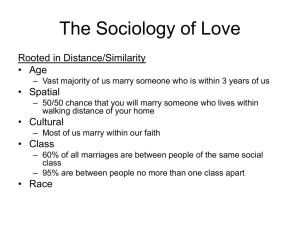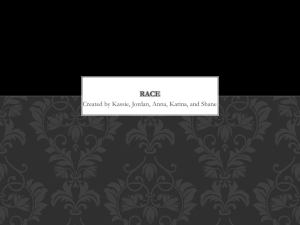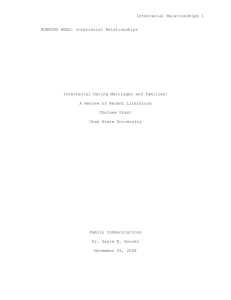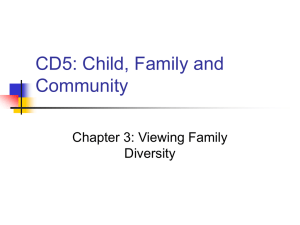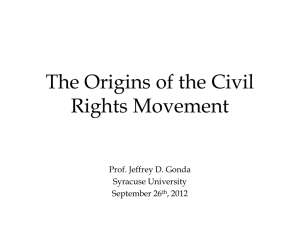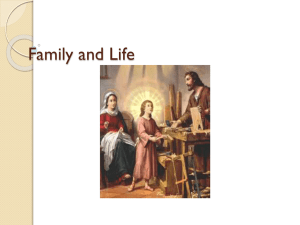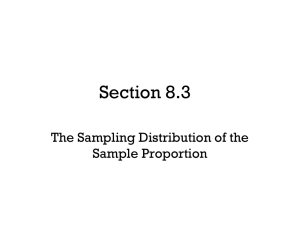Is the Pot Melting
advertisement
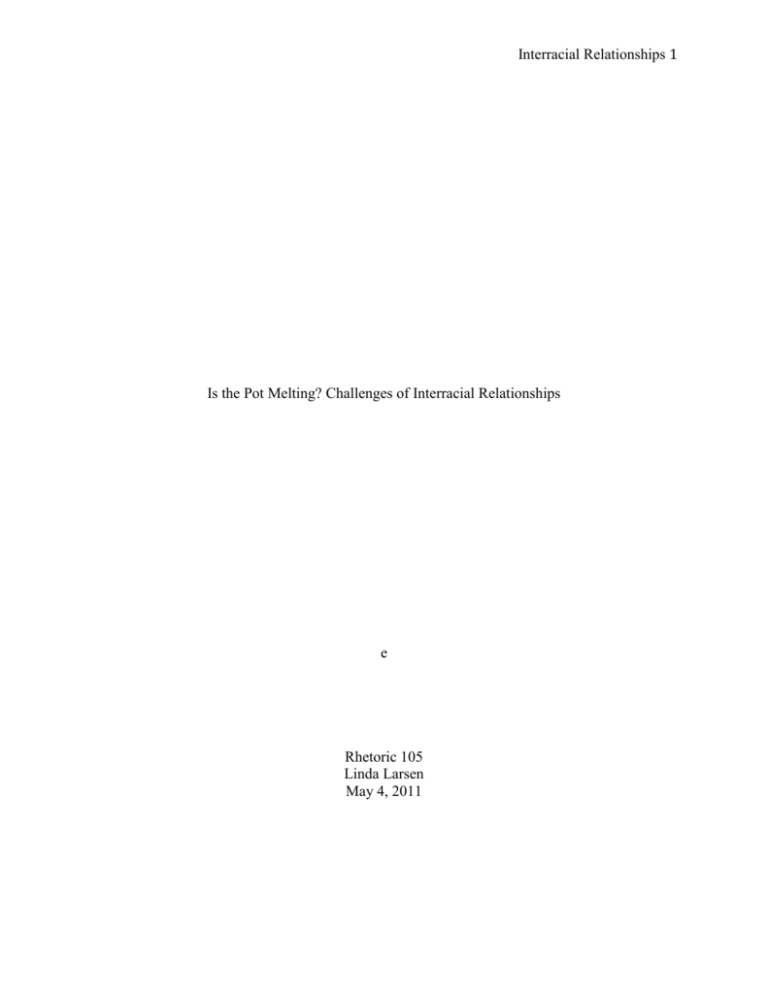
Interracial Relationships 1 Is the Pot Melting? Challenges of Interracial Relationships e Rhetoric 105 Linda Larsen May 4, 2011 Interracial Relationships 2 Abstract History has shown the progression of our country, in society’s acceptance of interracial dating. Our research primarily focused on interracial relationships between heterosexual, CaucasianAsian couples at the University of Illinois. We asked if couples faced internal and external challenges based on race at the University of Illinois. Through interviews and surveys, we found that couples cannot be generalized into one category and that each couple’s situation is unique. While most couples seemed to no experience few if any challenges, there were still a few couples and survey answers that stated otherwise. Keywords: interracial; dating; challenges; barriers; Asian Interracial Relationships 3 Is the Pot Melting? Challenges of Interracial Relationships America is known as the melting pot of the world as people of all cultures gather here to live. However, it has been frowned upon to mix with people of other races. Just in the last 30 years, intermingling of races has become prevalent, but society has pushed towards couples to stick to their own. It has always been traditionally thought that regardless of societal disapproval, cultural differences and language barriers were too hard to overcome. With times changing and society evolving, the number of interracial couples is growing and opening up to the world. In fact, Asian-Caucasian relationships are the most common of interracial relationships. The cultural disparity between the two groups is astounding, however statistics show that they frequently date. Even though the University of Illinois is a diverse campus, it does not necessarily mean students have become fully accepted by others, especially those who are involved in interracial relationships. Despite the racial gaps, interracial relationships are succeeding more then ever because society’s every growing acceptance. Acceptance in interracial dating has changed throughout time. What was prevalent at universities in the 60’s may not be seen today. The current generation’s grandparents and parents help explain the progression. Roughly three decades ago, interracial couples were not tolerated or accepted in colleges around the nation. Most notably at Bob Jones University, a Christian college located in South Carolina. The punishment for being involved with someone of another race could result in imprisonment, beating, or even death. These rules were instilled only recently in the late 1960’s and early 1970’s (Firmin & Firebaugh, 2008). It was not until 2000, when Bob Jones III discussed the controversy on Larry King Live, the ban was officially seen as uplifted from the university (“Bob Jones,” 2000). This not only reflects the intolerance in universities for interracial dating, but it also shows the students and administrators’ ideologies. Interracial Relationships 4 Fortunately, the history of acceptance is rapidly changing throughout universities across the nation. Now on college campuses, the diverse student body provides equal opportunity for racial groups to intermingle (McClintock, 2010). On a campus observation by Eileen Langman, the most prevalent interracial couple was between Asian and Caucasian students (2009). Her observations provide a perfect reflection of the societal trends concerning interracial relationships. Thus supporting the claim that Asians are most likely to engage in interracial relationships. Trends we see in campus life today reflect the growth in acceptance over the years. Through what it has been, to what it is today, interracial dating has become much more widely accepted. But even though it has generally become more accepted, there are still people who are skeptical. There are multiple factors that lie on how different interracial relationships function and are accepted. Acceptance of interracial couples also relies on how serious the relationship is. Some people have the view that dating is ok because it is not considered to be permanent. When it is considered a serious relationship – even marriage – dating can be seen as joining two families together: permanently. Although dating has become accepted, marriage is still predominately encouraged to be same race. This is just one of the factors that effects people’s views upon interracial couples. But students can now see past the color and look at common interests instead and interracial marriage now too, has become more accepted then before. Lewis (2010) shows in his journal that marriage between Caucasians and people of other descent increased from 26% to 72% from the years of 1990 to 2000 (p.414). In numbers, “interracial marriages increased from 1,542,000 to 4,500,000” (Lewis, 2010, p.415). The research was done to prove that interracial marriages and dating is definitely increasing. But the Interracial Relationships 5 numbers are still not high enough to support society’s comfort levels. Society seems to still exchange glances at interracial couples because they are still not fully comfortable by the relationship. Other factors can create rifts in how the relationship functions. It can be anything such as: language, culture, religion, history, or how the partner has assimilated to America (Lange, 2008). But in hope to take full advantage of American culture, Asian families will often encourage their adolescents to date Caucasians. However, Chinese families still primarily promote relationships with other Chinese people so that heritage cannot be lost. Preservation of culture is still very important to certain families. Language and communication are some of the most important factors in a successful relationship. According to Lange (2008), a major issue is a communication problem between the parents and the couples, especially if the parents are immigrants. Although some couples do not face any problems with language barriers, it may affect the couples’ parents. This puts a great amount of pressure placed on interracial couples. For example, language barriers and miscommunication can lead to arguments. This pressure and stress that interracial couples hold may play a role in an unhealthy or short-lived relationship. Moreover, couples may also face cultural differences like the celebration of different holidays, traditions, and different views on which behaviors are accepted. In Lange’s article (2008) he states, “In Korea, respect is huge; if someone is older than you they deserve the utmost respect no matter what the situation” (p. 6). He goes on to explain a time when one of his Korean friends took his Caucasian friend to Korea and got scolded for not offering his seat to an elderly man. Korea and China also celebrates New Years later then Americans do, and they do not celebrate Thanksgiving. Interracial Relationships 6 A great amount of satisfaction in an interracial relationship comes from the approval of the couples’ family members and their friends. From an interview Lange (2008) conducted, he found that his interviewee said, “My father is hands down, flat out against the idea, without a doubt. He wants me to date a nice Korean guy, no question” (p. 4). In some cases, the couples have completely different groups of friends, which make it difficult for them to interact. But in accordance to numbers, interracial couples are increasing today more then ever. Methods Our primary research objective was to evaluate whether or not couples are accepted today. With numbers and testimonies producing different slightly different results, we wanted to examine how society was still integrating with the idea of interracial couples. We wanted to compare what others have found on this developing issue to what we could find at the University of Illinois. To understand how widely accepted interracial relationships were at the University of Illinois campus, the group interviewed students who are currently involved in heterosexual, interracial relationships. Interviewees varied from Asian American, International Asian, and Caucasians students but all students currently enrolled at the University of Illinois. Cloud* is an Asian American male dating a Caucasian female, Rikku* is a Caucasian female dating an International Asian male, Kim* is an International Asian dating a Caucasian female, Zach* is a Caucasian male dating an Asian American female, and Sarah* is an Asian American female dating a Caucasian male. In the interviews, questions were asked about each of their respective relationships. In addition to the interviews, a survey was administered to 30 University of Illinois students at random. The surveys consisted of yes or no questions that asked about openness to interracial relationships and past experiences. Interracial Relationships 7 *Names have been changed Results The survey and interviews produced similar results to support our research to see whether or not interracial couples are more widely accepted. First, we examined the results of our surveys. One question we asked on our survey was: “Would you be open to an interracial relationship?” The result showed that 83% of the people are open to interracial relationship. A heavy majority of the following people also stated that they view interracial relationships differently then their grandparents and parents. Although 70% of the people surveyed were not currently in an interracial relationship, out of the 30% who were, 60% surveyed that the termination of the relationship did not result from racial barriers. Also, given the range of 1-10 to the question, “How open do you think society is to the idea of interracial relationship?” the average was 6.468. The last question was, “Would you ever consider developing a relationship with someone other then your race?” A large majority of 87% agreed to consider being in an interracial relationship, which was higher percentage than expected. Overall, the survey strongly supported the research conclusion of higher acceptance rate of interracial relationship in our society. Just like the survey, the resulting interviews also support the conclusion. For the research, we interviewed five people in the most common interracial relationship, Asian and Caucasian students. Kim, an international Asian, stated that she had both language and cultural barriers between her and her Caucasian boyfriend. She would try to explain in her thoughts in English, but with frustration, could not relay her thoughts. “Sometimes I would just talk to him in Korean and he would give me a response like, huh'” (personal communication, March 30, 2011)? Another interviewee answered that, “sometimes [they] have language barriers,” (personal Interracial Relationships 8 communication, March 30, 2011) but at a very minimum level. Although an Asian American couple that was interviewed said they do face a language barrier, the rest of Asian Americans in an interracial relationship said that the barriers did not result because of the difference in their race. Their issues steamed from issues all couples face, such as communication. One of the questions we asked was, “What are some of the barriers that you face in their relationship?” The interviewees answered that like any other relationship, communication was one of the barriers. One of the subjects, Zach, answered, “It’s like if I was going out with the same race or of similar skin color.” He did not even consider race as an issue in their relationship. The response from Zach was very similar for Cloud. He did not face any racial barriers. If they did have conflicts it was because of other reasons. Discussion From our research, we found that there were not many challenges or barriers that interracial couples came across. Language was not an issue between two couples because most of the interviewees and their partners were American born and fluent in English. However in the case of Kim, she had a very strong Korean background and found communication as the biggest barrier in her relationship. This could have been due to the fact that Kim is an international Asian student who is more comfortable with the Korean language as opposed to the other American born interviewees who are more comfortable with speaking English. It was somewhat surprising to find that in these interracial relationships, a lot of family acceptance and parental approval was present. Generally people hide their relationships due to pressures from their family and friends but this was not the case for Interracial Relationships 9 the interviewees Rikku, Cloud, Sara, or Zach. They were free to be with whomever they wanted to be with, so the guidance was reassuring for their relationships. It gives them hope and even the possibility of marriage in the future. Furthermore, in Cloud’s case, his parents were accepting of his relationship but they had a different set of priorities for him in mind. They wanted him to focus more on his studies and professions rather than spending time with his girlfriend, which could ultimately result in mother-son tensions. Like Rikku and Zach, Sara’s parents had no problems with her boyfriend, John, whatsoever. Her parents even had dinner with John’s parents and the outcome was what Sara had hoped for. “My parents accept him for who he is” (Personal Interview March 31, 2011). Besides feeling little to no negative pressure from parents, the interviewees felt that society had no negative pressure on them as well. Interviewee Sara stated, “I think society does not think much of it, as do we. At our generation now, there are so many interracial relationships” (Personal Interview March 31, 2011). Society can be accepting of some interracial relationships more than others, like the majority of the people surveyed believed, but that does not seem to have any effect on the couples we interviewed. Even if society is disapproving of some interracial relationships, people will not forwardly say it out loud. Thus, even if acceptance is not widely shown, it provides little to no hindrance on interracial couples. In order to look more into how society is more accepting of interracial relationships, our group surveyed 30 Asian and Caucasian students about their openness and other opinions towards interracial relationships. 25 out of 30 students surveyed said that they view the idea of interracial dating differently than their parents. The surveys showed that Interracial Relationships 10 our generation is more open to interracial relationships than older generations. We can expect an upward trend in acceptance as we replace our parents and grandparents. Our opinions will stay the same and will change the way society views different scenarios. The students who were surveyed were asked to rate how open they think society is to the idea of interracial relationships, with 1 being not open at all and 10 being extremely open, the results showed a combined average of 6.46. We found that society is not as narrow minded as before and is more accepting of these interracial couples. Only about 9 out of 30 people surveyed have been involved in an interracial relationship before but 21 out of 30 students would consider developing an interracial relationship. It was not surprising at all that the majority of the people who were surveyed said yes to being open to interracial relationships and would consider developing one. In our generation, not many people care about or look deep into someone’s race while choosing a dating candidate. What brings people closer together are shared interests and personality, not their race or color. Conclusion Society has made much more progress than we anticipated. The results show that interracial relationships are becoming much more widely accepted by society. The pressures that couples have previously faced are rapidly disappearing as time passes. Interracial couples encounter less and less obstacles that pertain to racial difference or cultural clashing. Regardless of race, all couples face problems during the courses of their relationships that challenge their strength and will. It is well known that interracial relationships will never become 100% fully accepted by society just as racial prejudices will never completely dissolve, but they will make as much progress as possible. Interracial Relationships 11 All couples face their own uphill battles every day, regardless of race. Hopefully in the future we will see upward trends in acceptance of interracial couples not only at the University of Illinois, but also in society. In ten to thirty years, we may start seeing an upward trend in statistics. As individuals, we can make it our responsibility that interracial relationships continue to not run into racial segregation from society. That way, citizens can be truly integrated and make the world feel a little smaller. References Bob Jones University Ends Ban on Interracial Dating. (2000, March 30). CNN. Retrieved from http://articles.cnn.com/2000-03-04/us/bob.jones_1_racist-school-ends-ban-bushsvisit?_s=PM:US Interracial Relationships 12 Firmin, M. & Firebaugh, S. (2008, September 1). Historical Analysis of College Campus Interracial Dating. Project Innovation, Vol. 42, Source 3. Retrieved from http://www. freepatentsonline.com/article/College-Student-Journal/182975270.html Lange, Nick (2008). Interracial Relationships and Korean American Families. Retrieved from University of Illinois, IDEALS Web site: httphttps://www.ideals.illinois.edu/handle/2142/8692 Langman, E. (2009). Asian America with Another Race Relationship. IDEALS McClintock, E. (2010). When Does Race Matter? Race, Sex, and Dating at an Elite University. Journal of Marriage & Family, 72(1), 45-72. doi:10.1111/j.1741-3737.2009.00683.x (2009). Romantic or Problematic. IDEALS Wang, H., & Kao, G. (2007). Does Higher Socioeconomic Status Increase Contact between Minorities and Whites? An Examination of Interracial Romantic Relationships among Adolescents. Social Science Quarterly, 88(1), 146-164. Retrieved from EBSCOhost.
